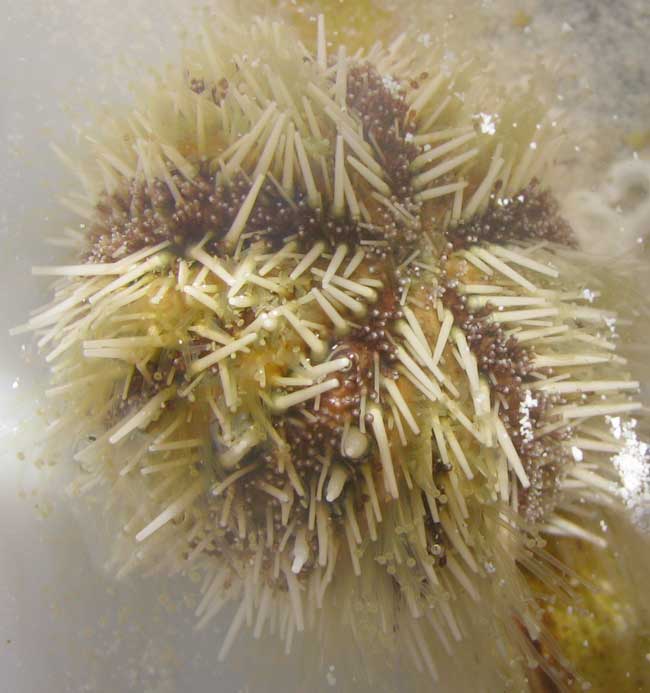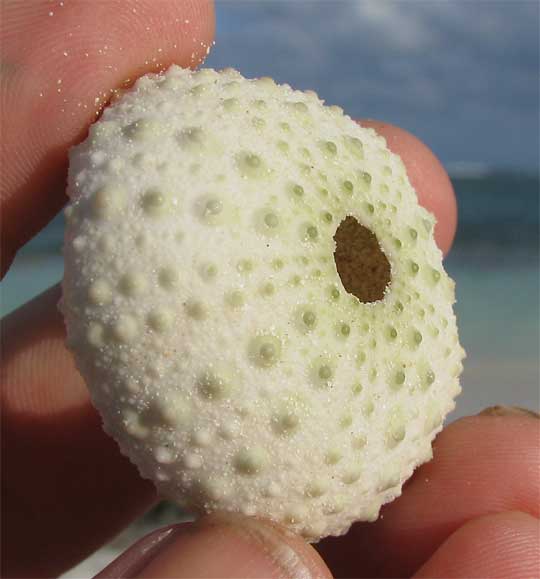Excerpts from Jim Conrad's
Naturalist Newsletter

from the May 8, 2011 Newsletter issued from Mayan Beach Garden Inn 20 kms north of Mahahual; Caribbean coastal beach and mangroves, ~N18.89°, ~W87.64°, Quintana Roo state, MÉXICO
A SEA URCHIN'S WAVING SPINES
In about a foot of water I was working my hand through a dense stand of Turtlegrass, Thalassia testudinum, just to see what was there. It wasn't long until my fingers wrapped around something like a heavy, spiny egg, and that spiny egg seemed to be sticking to my fingers...
Lifting the thing from the water I realized that during my earlier stay here I'd found cast-up remains of such a creature on the beach. (See next section.) The living, spiny specimen found this week is shown at the top of this page.
That's the Variegated Sea Urchin, LYTECHINUS VARIEGATUS, sometimes also called the Green Sea Urchin. The species commonly occurs in calm, clear waters from North Carolina and Bermuda southward through the Caribbean, to Brazil. Beds of Turtlegrass may constitute its favorite of all habitats.
I wanted to take a good look at this strange little being that somehow stuck to my fingers so I picked up a trash plastic cup that had floated onto the beach and filled it with seawater, put the urchin in it, got on my hands and knees, and began watching.
It was amazing. The spines weren't fixed in place as I'd imagined, but rather slowly waved back and forth. Also, there were slender projections among the spines wiggling even more energetically than the spines. With my digital camera I made a video. If your viewer can handle YouTube videos and Javascript, you see the moving spines below.
In that video you can see the urchin not only shifting from place to place, but also slowly working a leaf of Turtlegrass across its spine tips. How can a spiny sphere be so mobile and manipulative? And where does its stickiness come from? I could hardly wait to Google my questions on sea urchin anatomy.
It turns out that not only spines radiate in every direction from the spherical urchin body, but also there are hundreds of "feet," which are thin, muscular tubes with suction cups at the ends. So, those feet with their suction cups accounted for the animal's "stickiness," and the waving feet and spines together enabled the creature to shift about and move its Turtlegrass leaf. In the video, best I can determine, the lines of dark, shorter, fast-waving items between the white, longer spines are the feet.
One last surprise about my sea urchin: That hole at the top isn't the mouth as I'd assumed, but rather the tail hole. The mouth is at the bottom.
Stanford University offers a nice page on Sea Urchin anatomy and physiology, with some diagrams, at http://www.stanford.edu/group/Urchin/anaphys.html.
from the December 8, 2008 Newsletter issued from Mayan Beach Garden Inn 20 kms north of Mahahual; Caribbean coastal beach and mangroves, ~N18.89°, ~W87.64°, Quintana Roo state, MÉXICO Above you see something found occasionally along the beach here. Can you imagine what it is -- animal, vegetable or mineral? The first time I found such a thing I was completely stumped until one day one turned up bearing long, slender, black spines weakly attached to each bump on the shell's surface. Instantly I realized it was a sea-urchin -- or rather a dead sea-urchin's bleached, de-spined shell. This one looks like Lytechinus variegatus. Wikipedia does a pretty good job providing an overview of sea-urchin life history at https://en.wikipedia.org/wiki/Sea_urchin. Below is a shell with many of the spines still attached.
SEA URCHIN SHELL

